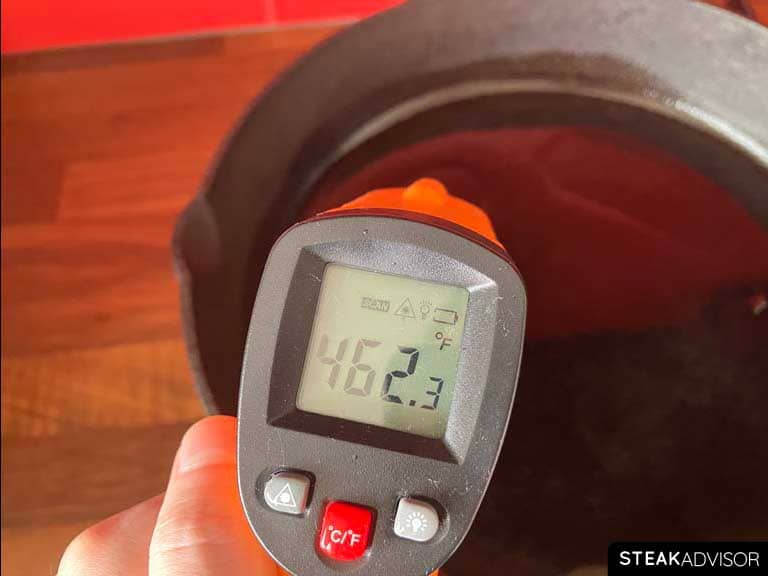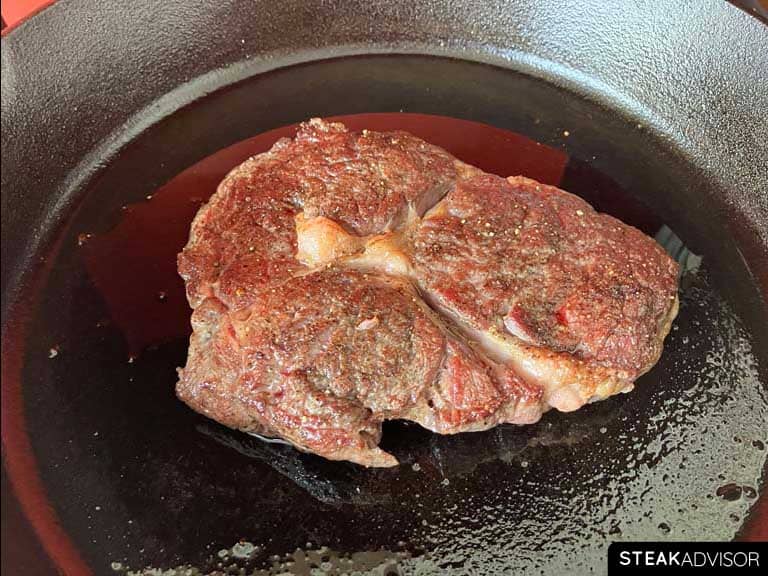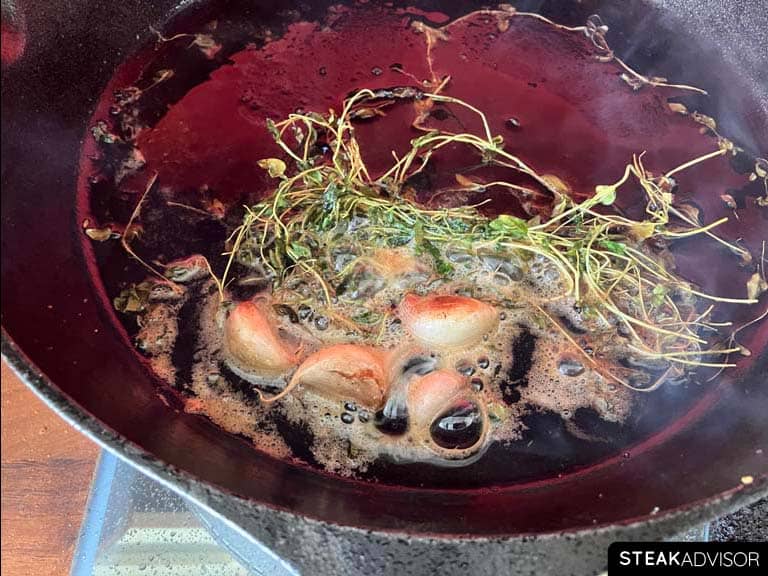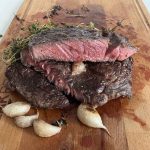| PREP TIME | REST TIME | COOK TIME |
| 5 mins | 45 mins to 6 h | 10 mins |
A thin ribeye steak, about 1 inch (2.5 cm) thick, cooks fast and doesn’t give you much room for error. It’s easy to end up with either a great crust and an overcooked center, or a pink middle but no sear. Still, with the right method, you can get both. I’ll show you how to pan-sear a thin ribeye so it comes out with a nice crust and a juicy, medium-rare center, then boost the flavor with simple aromatics like garlic, butter, and fresh herbs.
To make it easier, I’ve included two versions of this recipe: a quick overview for when you just need the basics, and a full step-by-step guide with photos and extra tips.
Important
I developed this recipe for ribeye steaks that are about 1 inch (2.5 cm) thick. If your steak is thinner or thicker, you’ll get better results by following one of my other recipes:
- 0.5-inch (1.3 cm) Steak in a Pan
- 1.5-2 inch (3.8-5 cm) Steak in a Pan
- 2.5-inch (6.3 cm) Steak in a Pan
You can use thinner cuts, but with very thin steak, it’s hard to achieve both a good sear on the outside and a juicy, pink inside. That said, if you like your steak cooked to medium or medium-well, thinner cuts are fine. You’ll have a little extra time in the pan to build a better crust before the inside overcooks.

The Ingredients You’ll Need
- Ribeye Steak: About 1 inch (2.5 cm) thick
- High-smoke-point oil: 1–2 tablespoons (15–30 ml), I recommend refined avocado oil
- Kosher salt: 1 teaspoon
- Black pepper: 1/2 teaspoon
- Fresh herbs: A few thyme sprigs or rosemary
- Garlic: 2–3 cloves, peeled
- Unsalted butter: 2 tablespoons (28 g)
The Tools You’ll Need
- Pan (Cast-iron, carbon steel, or heavy-bottomed stainless steel skillet)
- Tongs
- Instant Read Thermometer
How to Cook Thin Ribeye Steak – Step by Step Photos
Start by gathering your ingredients and tools, then follow the steps below. Watch for the notes, they’ll help you build a great crust while keeping the center medium-rare.

Step 1: Prepare the Steak
Pat the ribeye dry on all sides with paper towels. Season both sides generously with kosher salt. Then, if you’re short on time, let the steak rest at room temperature for 45–60 minutes on a wire rack set over a baking sheet. For a deeper flavor and a better crust, place it in the refrigerator uncovered for 4–6 hours. Whichever method you choose, remember to take the steak out of the fridge about 20 minutes before cooking.
Note
For the best crust, the steak’s surface must be completely dry. When you salt a steak, the salt first pulls moisture to the surface; this peak occurs after about 15–20 minutes. Over the next 45–60 minutes, most of that liquid gets reabsorbed, leaving the outside dry enough for a good sear. That’s why one hour of resting after salting is the bare minimum if you want better browning and flavor.
That said, one hour is really just the minimum. For this recipe, I developed it around the 4–6 hour salting method. After several hours, the surface becomes completely dry, which is especially important for thinner ribeye cuts (1 inch / 2.5 cm thick). You also get a deeper, more concentrated flavor. Trust me, those extra hours make a huge difference in both taste and crust.
Always let the steak rest at room temperature before cooking. For thicker cuts, 30 minutes at room temperature is perfect; however, for a thinner ribeye, 20 minutes is enough. This short rest helps the meat cook more evenly all the way through, so you don’t end up with a red spot in the center.
Step 2: Preheat the Pan
Place a heavy, thick-bottomed pan over medium-high heat; for best results, I recommend using a cast-iron skillet. Let it heat for 3-4 minutes. Then add 2 tablespoons (30 ml) of oil and wait another minute. While the pan heats, pat the steak dry one more time and season both sides with finely ground black pepper. When the skillet is hot and the oil is shimmering, you’re ready to sear.
Note
A hot pan is the key to a proper sear. The Maillard reaction (browning) speeds up dramatically when the steak’s surface reaches approximately 300°F (150°C). Because the pan cools the moment the steak hits it and any surface moisture holds the temperature near 212°F (100°C) until it evaporates, preheat the skillet hotter. Aim for about 450°F (232°C) so the surface stays hot enough for a hard sear. In my tests with a cast-iron skillet, 4-5 minutes of preheating usually brings it right into that range.
That level of heat requires the right tools. Use a heavy pan (cast iron is best; carbon steel or thick stainless steel also works) and a high-smoke-point oil (such as refined avocado oil with a smoke point of around 500°F / 260°C or alternatives listed below).
| Type of Fat | Smoke Point ºF | Smoke Point ºC |
|---|---|---|
| Refined Avocado Oil | 520ºF | 270ºC |
| Refined Safflower Oil | 510ºF | 266ºC |
| Beef Tallow | 480ºF | 250ºC |
| Pecan Oil | 470ºF | 243ºC |
| Refined Peanut Oil | 450ºF | 232°C |


Step 3: Pan-Sear the Steak
Ensure your exhaust fan is on or a window is open, as searing at high heat creates plenty of smoke. Place the steak gently in the hot pan and press it with tongs so it makes even contact with the surface. Flip the steak every 30–45 seconds to build an even crust and prevent the gray band under the surface from getting too thick.
Cook until the internal temperature is about 20°F (11°C) below your target doneness (see the temperature chart below), then remove the steak from the pan. Let it rest on a cutting board for about 5 minutes. While the steak rests, move on to the next step.
Here’s a simple temperature chart showing when to remove the steak from the pan to reach your preferred doneness:
| Doneness | Remove at temp: | Final temp: |
| Rare | 100–110°F (38–43°C) | 120–130°F (49–54°C) |
| Medium Rare | 110–120°F (43–49°C) | 130–140°F (54–60°C) |
| Medium | 120–130°F (49–54°C) | 140-150˚F (60–66°C) |
| Medium-Well | 130–140°F (54–60°C) | 150-160˚F (66–71°C) |
| Well Done | 140–150°F (60–66°C) | 160°F+ (71°C+) |
Note
You might wonder why I recommend removing the steak when it’s still about 20°F (11°C) below your target doneness. That’s because taking the steak out of the pan doesn’t stop the cooking process. As it rests, the internal temperature continues to rise due to residual heat, a process called carryover cooking.
When cooking over direct, very high heat (as in this recipe), carryover cooking is significantly bigger than most guides suggest. Instead of rising just 5–10°F (3–6°C), the temperature often rises by around 20°F (11°C) during the 5–7 minutes of resting. If you don’t account for that rise, you risk overshooting your target and ending up with an overcooked steak.
Since a 1-inch (2.5 cm) ribeye is relatively thin, I focus on cooking it correctly in this step first. Once it’s off the heat and resting, you can move on to the aromatics without worrying about overcooking.

Step 4: Add the Aromatics
Add the garlic cloves and fresh herbs (a few sprigs of thyme or rosemary) to the hot pan. Sear the garlic until lightly browned. Reduce the heat to medium-low, then add the butter. Once the butter has melted, turn off the heat and move on to the final step of the recipe.
Note
Browning the aromatics in the same pan you used for the steak infuses the butter with extra flavor. This creates a rich, aromatic base that you can spoon over sliced steak, just before serving.
Pay attention to reducing the heat, as butter burns quickly over very high heat. Usually, I suggest adding aromatics while cooking the steak. However, with a thin ribeye, the searing time is so short that it’s better to separate these steps. Don’t worry, the flavor will be just as good.

Step 5: Serve the Steak
After the steak has rested, slice it thinly to your liking. Ribeye is tender and flavorful, so it will be delicious no matter how you cut it. Spoon the pan juices over the slices and finish with the seared garlic and herbs before serving.


Thin Ribeye Steak Recipe
- Prep Time: 5
- Rest Time: 1 hour
- Cook Time: 10
- Total Time: 1 hour 15 minutes
Description
Learn how to cook a thin ribeye steak (about 1 inch / 2.5 cm thick) with a nice crust and juicy, medium-rare center. Finished with garlic, herbs, and butter, this simple method gives you steakhouse-quality flavor at home in just minutes.
Ingredients
For Steak:
- Ribeye Steak (About 1 inch /2.5 cm thick)
- 2 tablespoons (30 ml) of high-smoke-point oil (I recommend refined avocado oil)
- 1 teaspoon kosher salt
- 1/2 teaspoon black pepper
- A few thyme sprigs or rosemary
- 2–3 garlic cloves
- 2 tablespoons (30 g) unsalted butter
Tools:
- Pan (Cast-iron, carbon steel, or heavy-bottomed stainless steel skillet)
- Tongs
- Instant Read Thermometer
Instructions
- Prepare the Steak: Pat the ribeye dry on all sides with paper towels. Season both sides generously with kosher salt. Then, if you’re short on time, let the steak rest at room temperature for 45–60 minutes on a wire rack set over a baking sheet. For a deeper flavor and a better crust, place it in the refrigerator uncovered for 4–6 hours. Whichever method you choose, remember to take the steak out of the fridge about 20 minutes before cooking.
- Preheat the Pan: Place a heavy, thick-bottomed pan over medium-high heat; for best results, I recommend using a cast-iron skillet. Let it heat for 3-4 minutes. Then add 2 tablespoons (30ml) of oil and wait another minute. While the pan heats, pat the steak dry one more time and season both sides with finely ground black pepper. When the skillet is hot and the oil is shimmering, you’re ready to sear.
- Pan-Sear the Steak: Ensure your exhaust fan is on or a window is open, as searing at high heat creates plenty of smoke. Place the steak gently in the hot pan and press it gently with tongs so it makes even contact with the surface. Flip the steak every 30–45 seconds to build an even crust and prevent the gray band under the surface from getting too thick. Cook until the internal temperature is about 20°F (11°C) below your target doneness (see temperature chart), then remove the steak from the pan. Let it rest on a cutting board for about 5 minutes. While the steak rests, move on to the next step.
- Add the Aromatics: Add the garlic cloves and fresh herbs (a few sprigs of thyme or rosemary) to the hot pan. Sear the garlic until lightly browned. Reduce the heat to medium-low, then add the butter. Once the butter has melted, turn off the heat and move on to the final step of the recipe.
- Serve the Steak: After the steak has rested, slice it thinly to your liking. Ribeye is tender and flavorful, so it will be delicious no matter how you cut it. Spoon the pan juices over the slices and finish with the seared garlic and herbs before serving.
Notes


